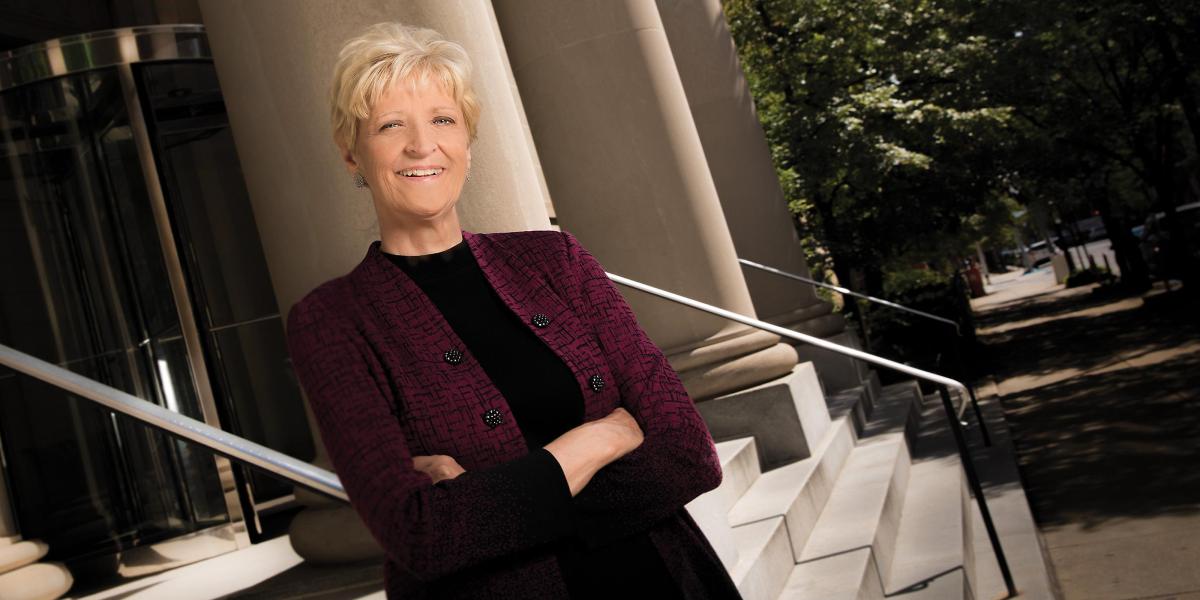Ellen’s Take - Fall 2017
My first year in public health was challenging, eye-opening, and fantastic.
A math major at a small liberal arts college, I moved straight from my undergraduate years to the doctoral program in Biostatistics here at the Bloomberg School. Suddenly I was sitting in classes next to health ministers and midcareer health professionals from around the world. They had already committed themselves to bettering the public’s health and came to the School to broaden their thinking and hone their skills. I, on the other hand, was still searching for a meaningful way to apply my love of math and problem-solving.
Although that first year of coursework in areas very new to me was a bit overwhelming, I learned a lot and grew in important and exciting ways. I recently had a good laugh with Chuck Rohde, my adviser at the time, about how I’ve grown from a very green, very young doctoral student in the late 1970s to dean of the oldest and largest graduate school of public health in the world. That professional journey in public health—almost all of it made here at the School—has in many ways been a constant push-pull between wide-ranging biostatistics and focused work on a specific issue, between research and leadership. I love few things more than working with colleagues to define an important research question, design a study, collect the data, analyze the results and build a body of evidence that leads to change in policy or practice. At the same time, I enjoy leading teams and organizations. Solving big problems, marshaling resources toward a common goal and mentoring young faculty and students have all been gratifying experiences. This is why I have found myself over the years juggling leadership and research opportunities.
I was still a doctoral candidate when I got my first big break as a junior biostatistician with what is now the Center for Health Services and Outcomes Research.

We researched financing and outcomes of emergency medical services and trauma systems—an opportunity that would shape my research career. Great mentors like Sam Shapiro, Don Steinwachs and Sue Baker guided me. I learned much from them and about myself. Most important, they listened to my ideas and encouraged me to think outside the box. While evaluating a well-established scale for measuring injury severity, I began to question whether it could do more than just predict whether patients would live or die. A Robert Wood Johnson Foundation grant allowed us to follow trauma survivors for one year. One finding surprised us: Among people whose principal injury was a severe leg fracture, only a little over half had returned to work within one year. A subsequent NIH-funded study showed that for patients with the most severe leg injuries, amputation or reconstruction of the salvaged limb did not appear to make a difference in long-term, everyday functioning. Instead, the more powerful predictors of good outcomes were self-efficacy, social support and effective management of early signs of depression and acute stress. We learned the critical importance of meeting the psychosocial needs as well as the physical needs of the patient.
I followed this line of research for decades and ultimately founded the Major Extremity Trauma Research Consortium (METRC) eight years ago. Funded by the Department of Defense, this network of over 50 military and civilian trauma centers works to define best practices for treating both service members and civilians with major limb trauma. METRC has coordinated more than 20 multicenter trials addressing pain management, the prevention of infections, and the optimization of rehabilitation strategies, among other issues.
Planning, setting measurable goals and focusing on results are all part of my personality. These attributes have defined my leadership style in the past and will serve me well as dean.
As much as I love collecting and analyzing data, I also enjoy leading teams and organizations. My first leadership experience was as director of the School’s Center for Injury Research and Policy. Even as I continued my research, I took on subsequent leadership roles as senior associate dean for Academic Affairs and then chair of Health Policy and Management. As chair, I most enjoyed recruiting and mentoring extraordinary young faculty, learning about public health challenges outside of my own expertise and helping foster new initiatives in research, practice and education. Along the way, I learned that planning, setting measurable goals and focusing on results are all part of my personality. These attributes have defined my leadership style in the past and will serve me well as dean.
I’ve had the privilege of knowing four of my predecessors: John Hume (who kindly agreed to serve on my dissertation committee after stepping down as dean), D.A. Henderson, Al Sommer and Mike Klag. I learned much from each of them, observing how they made critical decisions and how they contributed to the School and to public health. Each did so in his own way. I am humbled to follow in their footsteps. Of course, I will do things in my own way but pledge to uphold their tradition of excellence.
I’ve been fortunate in my career to have landed at the Bloomberg School, even if in the beginning I wasn’t sure of the path I would take. This remarkable institution has given me opportunities to move in different directions, to reinvent myself and to take on new challenges. I still feel the familiar push-pull. Even in assuming the great responsibilities of being dean, I won’t completely give up my research, though I will scale it back.
That push-pull has kept me engaged and challenged throughout my career. It will continue to help me grow as a person and a leader as I work with everyone in the Bloomberg School community on the most important mission in the world.
